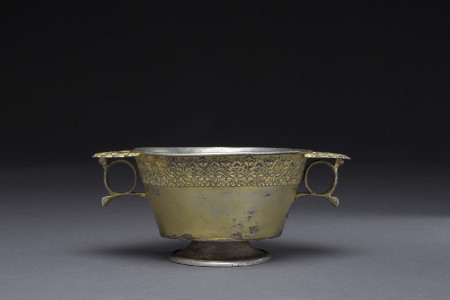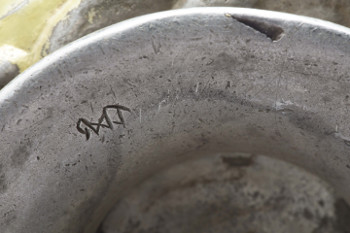
Item description
- Object: A Medieval silver-gilt two handled cup
- Date: 9th -10th century
- Culture: Khazar
- Dimensions: Width across handles 16.7 cm; height 6.8 cm
The object is a two-handled cup. It consists of a body in the form of an inverted truncated cone. It rests of a flared ring foot and has two loop handles surmounted by lobed thumb-plates with raised relief. One plate shows a hippocamp, the other a kneeling figure with a crown pointing.
There is a ring of raised kidney-shaped motifs on the base of the cup and a broad band of repeating stylised vegetable motifs including a three-lobed lotus-shaped form. The workmanship and detailing are superb, for example, the stylised lion heads on the lower tips of the handle loops. The outer surface of the cup including the decorative band, and the handles is gilded.
The cup is made up from several pieces, the bowl itself, the loop handles and the thumb-plates and the flared foot. The parts are soldered together presumably with a silver-copper solder although the visible joint areas are gilded and cannot be studied. The raising of the bowl was an exceptionally fine piece of silversmithing. It was done in such a way as to leave a widened rim and also a sufficient thickness in which to work the decorative band. This decorative band is not applied or cast, but worked into the silver. The handle components, on the other hand, may well be cast.
A series of analyses were carried out on various surfaces of the object using portable x-ray fluorescence analysis. The results were as follows (each an average of 3):
| Silver | Copper | Gold | |
|---|---|---|---|
| Silver of foot | 99.57% | 0.05% | 0.34% |
| Silver of bowl | 99.61% | 0.03% | 0.36% |
The silver is of remarkably high purity – the maximum that could be achieved by refining. The traces of gold are usual in silver produced before advances in silver refining in the nineteenth century. The areas of gilding revealed high levels of residual mercury. The presence of mercury shows that what is termed fire or mercury gilding was used. Mercury gilding was the usual method of gilding used between Roman times and the nineteenth century when it was superseded by electrogilding. The relatively high level of residual mercury is often encountered with early gilded silver objects. No elements were detected that would cast any doubt on the authenticity of the object.
Although the skyphos-shaped vessels are common for the Sarmatian period metalwork and appears to be unique for the medieval silverware of Eurasia, the style of the lotus-based floral ornaments and also the imagery used for the handles decoration reminds belts buckles and fittings that related to a Saltovo metalwork. This artistic tradition appears during the 9th-10th centuries on the territory of the Khazar Qaganate, an empire created by the semi-nomadic tribes on the lands of Western Eurasia. The silver vessels of such a quality and workmanship appears to be an extremely rare objects during the early medieval period, and thus the current silver-gilt cup represents one of a few survived very refine examples of the objects of precious metalwork that existed in the Khazar period.

